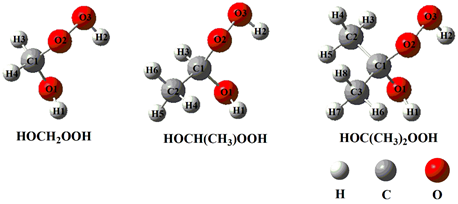Hydroxyalkyl hydroperoxides (HHPs), formed in the reactions of Criegee intermediates (CIs) with water vapor and in the initiation OH-addition with subsequent HO2-termination reactions, play important roles in the formation of secondary organic aerosol (SOA).
Recently, a research group from the Institute of Earth Environment of the Chinese Academy of Sciences (IEECAS) investigated the OH-initiated oxidation of the distinct HHPs (HOCH2OOH, HOCH(CH3)OOH and HOC(CH3)2OOH) formed from the reactions of CH2OO, anti-CH3CHOO and (CH3)2COO) with water vapor by using quantum chemical and kinetics modeling methods.
They found that the dominant pathway is H-abstraction from the –OOH group in the initiation reactions of OH radical with HOCH2OOH and HOC(CH3)2OOH. H-abstraction from the –CH group is competitive with that from the –OOH group in the reaction of OH radical with HOCH(CH3)OOH. The barrier of H-abstraction from the –OOH group slightly increases when the number of methyl groups increases.
The self-reaction of RO2 radical initially produces a tetroxide intermediate via an oxygen-to-oxygen coupling, then it decomposes into propagation and termination products through asymmetric two-step O–O bond scission. The rate-limiting step is the first O–O bond cleavage, and the barrier increases when the number of methyl groups increases.
The bimolecular reactions of distinct RO2 radicals with HO2 radical lead to the formation of hydroperoxide ROOH as the main product, and the barrier height is not affected by the number of methyl substitutions.
The reaction with O2 to form formic acid and HO2 radical is the dominant removal pathway for HOCH2O radical formed from the reaction of HOCH2OO radical with NO. The β-site C–C bond scission is the dominant pathway in the dissociation of HOCH(CH3)O and HOC(CH3)2O radicals formed from the reactions of NO with HOCH(CH3)OO and HOC(CH3)2OO radicals.
This study, published in Atmospheric Chemistry and Physics, was supported by the National Natural Science Foundation of China, Key Projects of Chinese Academy of Sciences, China, Strategic Priority Research Program of the Chinese Academy of Sciences, China, and CAS "Light of West China" Program.

Schematic diagram of the structures of distinct HHPs (Image by CHEN, et al)
Contact: Bai Jie, Institute of Earth Environment, Chinese Academy of Sciences, Xi'an, China. Email: baijie@ieecas.cn
 © 2015 Institute of Earth Environment,CAS
© 2015 Institute of Earth Environment,CAS Address:No. 97 Yanxiang Road, Xi'an 710061, Shaanxi, China

 Location :
Location :